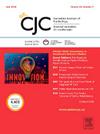Impaired Atrial and Ventricular Strain Predicts Heart Failure in Arrhythmogenic Right Ventricular Cardiomyopathy
IF 5.3
2区 医学
Q1 CARDIAC & CARDIOVASCULAR SYSTEMS
引用次数: 0
Abstract
Background
Arrhythmogenic right ventricular cardiomyopathy (ARVC) increases the risk of heart failure (HF) and arrhythmias. Speckle-tracking echocardiography (STE) detects myocardial dysfunction, but its predictive role for HF in this population remains unclear.
Methods
Seventy-one patients with ARVC (age 43.7 ± 14.8 years, 53.5% male) without prevalent HF at baseline who were enrolled in the Johns Hopkins ARVC Registry were retrospectively included. Global strain (GS) and strain rate (SR) of the left ventricle (LV), right ventricle free wall (RVFW), left atrium (LA), and right atrium (RA) were measured by a blinded operator. Cox regression models assessed their association with incident HF.
Results
Incident HF developed in 23 patients (age 49.3 ± 12.5 years, 52.2% male) during a median follow-up of 2.7 years. Decreases in strain were significantly associated with HF: LV peak global longitudinal systolic strain (GLS; hazard ratio [HR] 1.20, 95% confidence interval [CI] 1.06-1.35; P = 0.003), RVFW strain (HR 1.11, 95% CI 1.04-1.18; P = 0.003), LA GS (HR 1.05, 95% CI 1.00-1.09; P = 0.030), and RA GS (HR 1.07, 95% CI 1.03-1.12; P < 0.001). Associations for LV GLS, RVFW strain, and RA GS remained significant after adjusting for age and sex. Strain values frequently fell below established reference ranges. Any strain value (LV GLS, RVFW strain, LA GS, or RA GS) below the normal limit was associated with an 8-fold increase in HF (HR 8.43, 95% CI 1.97-36.02; P = 0.004), and each individual component below the normal threshold doubled the risk (HR 2.35, 95% CI 1.60-3.45; P < 0.001).
Conclusions
STE deformation abnormalities are associated with incident HF in ARVC patients. Echocardiographic strain may aid in identifying patients at risk of HF for closer follow-up and management.

心房和心室应变受损可预测致心律失常右室心肌病的心力衰竭。
背景:致心律失常性右室心肌病(ARVC)可增加心衰(HF)和心律失常的风险。虽然斑点跟踪超声心动图(STE)检测心肌功能障碍,但其在该人群中对心衰的预测作用尚不清楚。方法:回顾性纳入71例基线时无流行HF的ARVC患者(43.7±14.8岁,53.5%男性),纳入约翰霍普金斯ARVC登记处。采用盲法测量左心室(LV)、右心室自由壁(RVFW)、左心房(LA)和右心房(RA)的总应变(GS)和应变率(SR)。Cox回归模型评估了它们与心衰事件的关联。结果:在中位随访2.7年期间,23例患者(49.3±12.5岁,52.2%为男性)发生心衰。应变减少与HF显著相关:LVGLS (HR: 1.20, 95% CI: 1.06-1.35, P=0.003)、RVFWS (HR: 1.11, 95% CI: 1.04-1.18, P=0.003)、lag (HR: 1.05, 95% CI: 1.00-1.09, P=0.030)和RAGS (HR: 1.07, 95% CI: 1.03-1.12, P)。结论:STE变形异常与ARVC患者发生HF相关。超声心动图应变可能有助于识别有HF风险的患者,以便进行更密切的随访和管理。
本文章由计算机程序翻译,如有差异,请以英文原文为准。
求助全文
约1分钟内获得全文
求助全文
来源期刊

Canadian Journal of Cardiology
医学-心血管系统
CiteScore
9.20
自引率
8.10%
发文量
546
审稿时长
32 days
期刊介绍:
The Canadian Journal of Cardiology (CJC) is the official journal of the Canadian Cardiovascular Society (CCS). The CJC is a vehicle for the international dissemination of new knowledge in cardiology and cardiovascular science, particularly serving as the major venue for Canadian cardiovascular medicine.
 求助内容:
求助内容: 应助结果提醒方式:
应助结果提醒方式:


